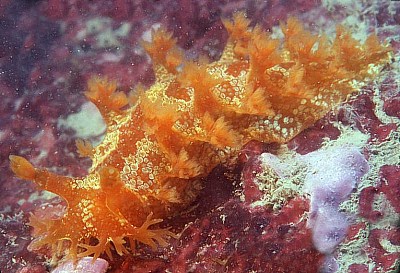
Marionia blainvillea
(Risso, 1818)
Order: NOTASPIDEA
Suborder: DENDRONOTINA
Family: Tritoniidae
DISTRIBUTION
Known from western Mediterranean and adjacent Atlantic waters
PHOTO
UPPER RIGHT: Adult - 04 November 2000, size: 5cm, Depth: 9m, La Grande Motte; south of France, near the Rhone Delta, Mediterranean coast of France. LOWER LEFT: Intermediate - 19 July 2001, size: 2cm, Depth: 16m, Cerbère; France-Spain border (night dive)- on Leptogorgia sarmentosa. LOWER RIGHT: Juvenile - 19 July 2001, size: 5mm, Depth: 12m, Cerbère; France-Spain border (night dive)- on Leptogorgia sarmentosa. Photos: Jean-Pierre Bielecki
Adults range in colour from a pale translucent orange to a deeper reddish brown witrh irregular patches of white. The back is covered in low bumps, each outlined with a darker line which forms a network over the body, Grows to approx 50mm long. See Jean-Pierre Bielecki's message showing the change in colour as the animal grows from a white juvenile.
Reported to feed on following octocorals: Alcyonium acaule, Alcyonium palmatum, Eunicella cavolinii, Eunicella singularis, Eunicella sp., Leptogorgia sarmentosa, Paramuricea clavata . [See Gary R. McDonald & James W. Nybakken's A List of the Worldwide Food Habits of Nudibranchs]
Reference:
• Risso, A. (1818). Memoire sur quelques Gasteropodes nouveaux, Nudibranches et Tectibranches observes dans la Mer de Nice. Journal de Physique, de Chimie, d'Histoire Naturelle et des Arts, 87: 368-377
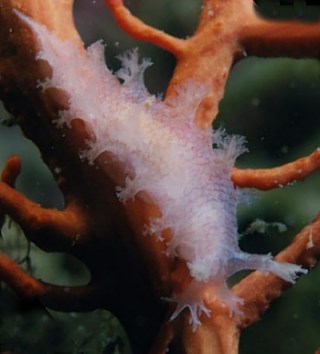
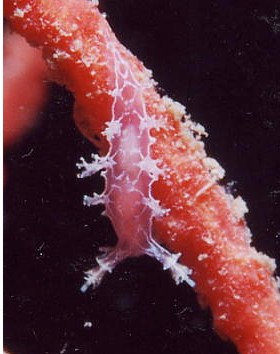
Rudman, W.B., 2001 (October 1) Marionia blainvillea (Risso, 1818). [In] Sea Slug Forum. Australian Museum, Sydney. Available from http://www.seaslugforum.net/find/mariblai
Related messages
Re: Food of Marionia blainvillea
October 2, 2009
From: Dominique Horst
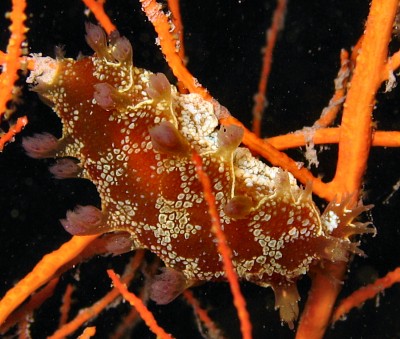
Concerning message #5510:
Hi Bill,
This is the first time I have seen a Marionia blainvillea crawling on the gorgonian Leptogorgia sarmentosa. It was probably feeding on it, but very few polyps were out.
Locality: Cagnes, 30 m, France, Mediterranean sea, 12 June 2009, muddy. Length: 35 mm. Photographer: Dominique Horst.
Kind regards,
Dominique
dominique.horst@wanadoo.fr
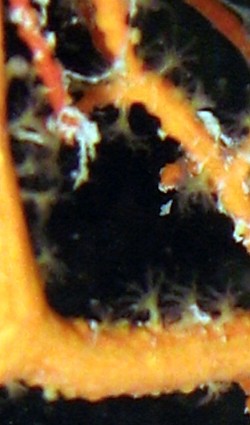
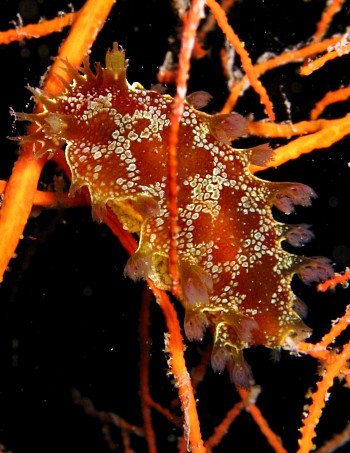
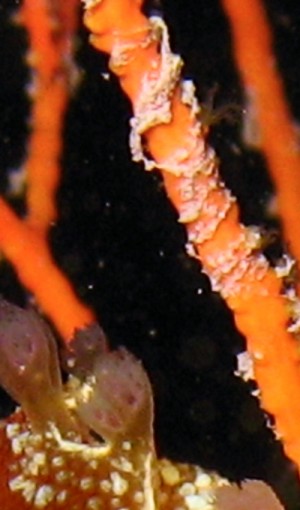
Thanks Dom,
I've cropped your photos a bit so we get a better view of the nudibranch, but in your original photos there were a lot of polyps out away from the Marionia. Sensibly, the gorgonian polyps can retract when they detect danger. Some gorgonian feeding nudibranchs eat the polyps and the basal tissue, which would mean that retracting the polyps wouldn't be much use, but this species of Marionia seems to daintily eat just the polyps.
In the upper photo I can see what looks like an old nudibranch egg ribbon spiralled around the gorgonian branch [see close-up alongside]. I suspect this belongs to Marionia. If so, it would mean the nudibranch has been on the colony for some time, which also suggests it is eating the polyps.
Best wishes,
Bill Rudman
Juvenile Marionia blainvillea from France
July 21, 2002
From: Marina Poddubetskaia
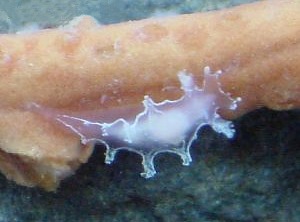
Dear Bill,
Here are some photos of juveniles of Marionia blainvillea.
Cerbere, France [Mediterranean coast], 3-4 July, 2002. Depth : 13m, Size : 5-6mm
Photos: Marina Poddubetskaia - Nembro website
Best wishes,
Marina.
nembro@nembro.info
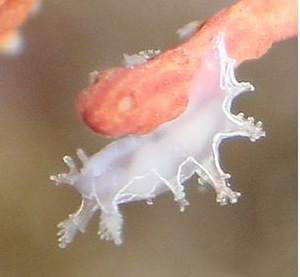
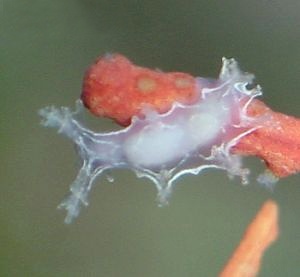
Thanks Marina,
Bill Rudman
Gluttonous Marionia blainvillea
December 12, 2001
From: Jean-Pierre Bielecki
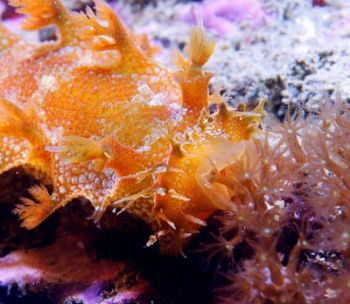
Hi Bill
We are sure you will be very interested in any firsthand information on the food habits of Marionia blainvillea. We were very lucky to assist to a special show: some gluttonous Marionia devouring the octocoralian Maasella edwardsii.
These pictures have been taken in La Grande Motte (south of France), dive site “Le Pic”, depth 9 meters, date 24 November 2001, size of the animals between 4 to 7 cm.
Best wishes
Jean-Pierre Bielecki
bielecki.jeanpierre@free.fr
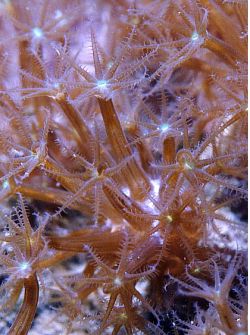
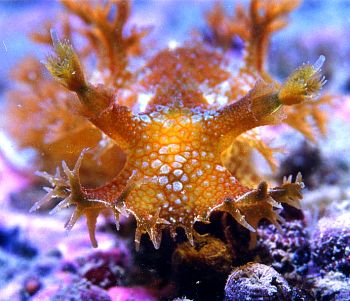
Dear Jean-Pierre,
Thanks very much. I am indeed interested in these photos of Marionia feeding.
Best wishes,
Bill Rudman.
Re: Food of Marionia blainvillea
October 24, 2001
From: Helmut Zibrowius
Dear Bill,
To accompany my message on gorgonian food of Tritonia nilsodhneri here are my comments on Marionia blainvillea.
• The two lower photos in Bielecki's message show the slug on what seems to be Leptogorgia sarmentosa (Esper, 1789). For a more comfortable identification of the host gorgonian, it would be preferable to see a larger part of the colony. This affirmedly is not Eunicella verrucosa. That other species also occurs in the Mediterranean, but is white and has a very different texture. Leptogorgia sarmentosa has been called Lophogorgia sarmentosa in older publications, but according to Grasshoff (1992) it should be placed into the genus Leptogorgia.
• The gorgonian in Miquel Pontes' message identified as "Lophogorgia" is correct but now placed in the genus Leptogorgia. It is also Leptogorgia sarmentosa.
• Concerning Baki Yokes' interesting finds in Turkey. The paper he refers to must be:
Demir M., 1952-1954. Bogaz ve Adalar sahillerinin omurgasiz dip hayvanlari [The invertebrate benthos of the Bosporus and of the litoral of the sea of Marmara closer to the Bosporus; in Turkish]. Hidrobiologi arastirma enstitusu yayinlarindan, 3: viii + 615 + 14 p., 235 fig., 15pl.
The gorgonians in his photos are very interesting and the fauna of the eastern Mediterranean is not very well known. I cannot say anything sensible about their identity without further examination, so I will contact Baki directly.
Reference:
LI> Grasshoff M., 1992. Die Flachwasser-Gorgonien von Europa and Westafrika (Cnidaria, Anthozoa). Courier Forschungsinstitut Senckenberg, 149: 135pp.
Helmut Zibrowius
Centre d'Oceanologie de Marseille Station Marine d'Endoume
Marseille
France
hzibrowi@com.univ-mrs.fr
Zibrowius, H., 2001 (Oct 24) Re: Food of Marionia blainvillea. [Message in] Sea Slug Forum. Australian Museum, Sydney. Available from http://www.seaslugforum.net/find/5510Thanks Helmut,
Bill Rudman
Marionia blainvillea food (2)
October 22, 2001
From: Baki Yokes
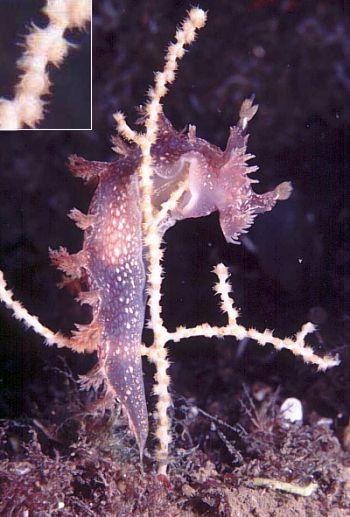
Dear Bill,
Here is another photo of Marionia blainvillea on its food. I am not sure if this gorgonian is the same as the two in my recent message. In an earlier message I sent photos of an adult and a juvenile on this gorgonian.
Place: Istanbul, Turkey
Divesite: Yassiada
Depth: 30m
Date: October, 2001
Colony height: approx. 8cm
Best wishes,
Baki
bakiyokes@turk.net
Yokes, B., 2001 (Oct 22) Marionia blainvillea food (2). [Message in] Sea Slug Forum. Australian Museum, Sydney. Available from http://www.seaslugforum.net/find/5544Thanks Baki,
As I said in your other message, if this is a separate species, it is the only one you have sent photos with Marionia blainvillea on it. Very interesting,
Best wishes,
Bill Rudman
Re: Food of Marionia blainvillea
October 22, 2001
From: Baki Yokes
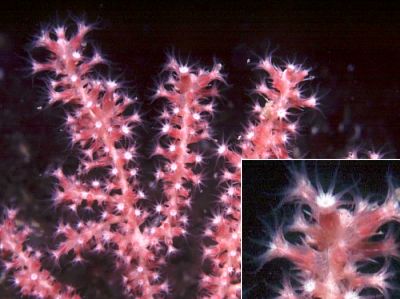
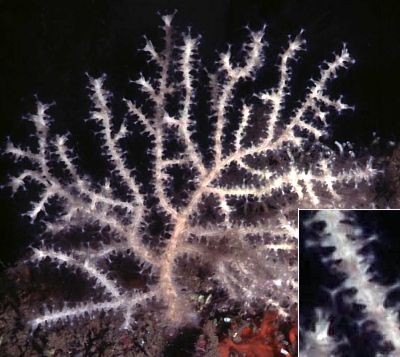
Dear Bill and Bernard,
I'm also not a sea fan expert, in fact not a marine biologist at all. But I had named this gorgonian as E. verrucosa, according to the detailed descriptions given in a university publication, concerning the marine invertebrates of Istanbul islands. The book is very well written but rather old (published in 1954). I may be wrong in identification, since I'm not an expert, or the book is out of date and should be updated, but what ever this species is, the Sea of Marmara has a very distictive characteristics which are very suitable for soft corals. It is composed of two main layers, the plankton-rich upper freshwater layer from Black Sea, and a lower, salty layer of Mediterranean water with constant temperature all throughout the year. If you go down to 25m of depth you reach the mediterranean water and also a field of soft corals with many different species that I have never seen during any of my Agean or Mediterranean dives. And in the depths of some islands that are near the Bosphorus Strait, it is possible to see these E. verrucosa? colonies on every rock. Sometimes they are in pink colur but in most of the cases they are creamy-white to light yellow. I also would be pleased if anybody identify these gorgonians.
UPPER PHOTO: Istanbul, Turkey. Divesite: Yassiada, Depth: 32m, August, 2000
Colony height: approx. 30cm
LOWER PHOTO: Istanbul, Turkey. Divesite: Sivriada, Depth: 28m, July, 2000
Colony height: approx. 25cm
I have sent a photo of a possible third form? or species? in a separate message
Thank you in advance
Best wishes
Baki
bakiyokes@turk.net
Yokes, B., 2001 (Oct 22) Re: Food of Marionia blainvillea. [Message in] Sea Slug Forum. Australian Museum, Sydney. Available from http://www.seaslugforum.net/find/5497Thanks Baki,
It looks like you may have more than one species of gorgonian. Hopefully someone will be able to sort them out. Once they are sorted out you will need to check just which 'species' or 'forms' Marionia blainvillea feeds on. At present your photos have shown it only on the species in your second message.
Best wishes,
Bill Rudman
Food of Marionia blainvillea
October 17, 2001
From: Bernard Picton
Hi Bill,
I'm not an expert on sea fans, but what Baki is calling Eunicella verrucosa in his message about Marionia blainvillea is in my opinion not this species. I think Eunicella verrucosa is rather scarce in the Mediterranean.
Bernard.
bernard.picton.um@nics.gov.uk
Picton, B.E., 2001 (Oct 17) Food of Marionia blainvillea. [Message in] Sea Slug Forum. Australian Museum, Sydney. Available from http://www.seaslugforum.net/find/5489Thanks Bernard,
Perhaps someone can help us out with an identification.
Bill Rudman
Marionia blainvillea from Turkey
October 11, 2001
From: Baki Yokes
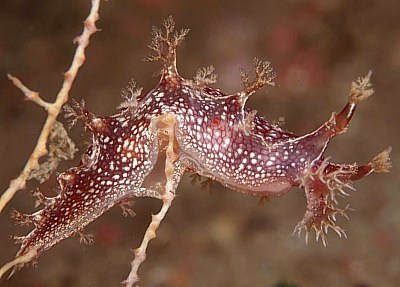
Dear Bill,
Here are some photos of Marionia blainvillea which is known to inhabit Western Mediterranean waters, as you have mentioned in the Forum. But surprisingly, these photos were taken around one of the Istanbul Islands, Yassiada, in the Sea of Marmara. Although we have been diving at this divesite more than 10 years, this was the first time we see these animals in our dives. It was also surprising to see that, around 30 meters of depth, there were 3-5 specimens on every piece of rock. They were mainly found on Eunicella verrucosa colonies, but not on any other type of coral.
Photographic data:
Yassiada Is, Istanbul, Turkey, Sea of Marmara, 29 September 2001.
UPPER RIGHT: Depth: 34m, Size: approx 70mm, Photo: Hasan Yokes: hyokes@turk.net
LOWER LEFT: Depth: 29m, Size: approx 15mm, Photo: Baki Yokes.
LOWER RIGHT: Depth: 32m, Size: approx 50mm. Photo: Baki Yokes.
Best wishes
Baki
bakiyokes@turk.net
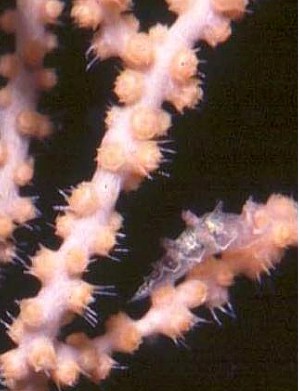
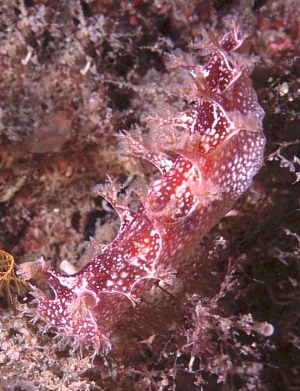
Dear Baki,
Thanks for these interesting photos. I am sure your observations are going to extend the known distributions of many Mediterranean opisthobranchs. It is also great that you have been able to confirm the juvenile to adult colour change so recently reported in the Forum by Jean-Pierre Bielecki.
Best wishes,
Bill Rudman
Re: Photos of Marionia blainvillea
October 6, 2001
From: Jean-Pierre Bielecki
Hi Bill
Here are the details about the three pictures of Marionia blainvillea:
• 'Juvenile' 19 July 2001, size: 5mm, Depth : 12m, Cerbère; France-Spain border (night dive)
• 'Intermediate' 19 july 2001, size: 2cm, Depth :16m, Cerbère; France-Spain border (night dive)
• 'Adult' 04 November 2000, size: 5cm, Depth: 9m, La Grande Motte; south of France, near the Rhone delta (day dive but with only 30cm visibility it was in fact like the worst night dive !! )
Best wishes
Jean-Pierre
bielecki.jeanpierre@free.fr
Bielecki, J-P., 2001 (Oct 6) Re: Photos of Marionia blainvillea. [Message in] Sea Slug Forum. Australian Museum, Sydney. Available from http://www.seaslugforum.net/find/5412Dear Jean-Pierre,
Thanks very much. I'll add them to your very informative photos. I had just assumed they were from the same place.
Best wishes,
Bill Rudman
Re: Miquel Pontes' Tritonia lineata?
October 3, 2001
From: Jean-Pierre Bielecki

Hi Bill
We think the species found by Miquel Pontes is not Tritonia lineata but a juvenile Marionia blainvillea. We are almost sure about this because we found ourselves many Marionia blainvillea in their juvenile or intermediate stage in the Gorgonian Leptogorgia sarmentosa (easy to find in night dive). Gery Parent kept one juvenile on its gorgonian in acquarium and saw the transformation in some weeks. Nevertheless, the adult species are more difficult to find (because they hide under rocks during the day) and they probably change their habitat (change their food?). In France, they are common in particular places in shallow (9 m) and murky water (visibility < 5 m) near the Rhone delta where the fixed marine life is very rich. In such places, they are so common that it is the attraction for the beginners because of their dance-like swimming when they are disturbed.
Here are 3 pictures of Marionia blainvillea showing the different stages:
UPPER RIGHT: Adult - 04 November 2000, size: 5cm, Depth: 9m, La Grande Motte; south of France, near the Rhone Delta, Mediterranean coast of France. LOWER LEFT: Intermediate - 19 July 2001, size: 2cm, Depth: 16m, Cerbère; France-Spain border (night dive). LOWER RIGHT: Juvenile - 19 July 2001, size: 5mm, Depth: 12m, Cerbère; France-Spain border (night dive). Photos: Jean-Pierre Bielecki
The gorgonian prey in lower two photos has been identified as Leptogorgia sarmentosa (Esper, 1789). See message from Helmut Zibrowius: 23 Oct 2001.
Best wishes,
Jean-Pierre Bielecki
bielecki.jeanpierre@free.fr


Dear Jean-Pierre,
This is indeed an interesting observation. It reminds me of Tritonia hombergi which also starts life as a white individual. It certainly shows the importance of studying populations, wherever possible, when naming or identifying species. Any chance of some approximate sizes for these animals please?
Best wishes & Thanks,
Bill Rudman.
Re: Possible Tritonia lineata? from Spain
October 3, 2001
From: Miquel Pontes
Dear Bill
Luís Sánchez Tocino (Universidad de Granada) suggested to us that our nudibranch is a juvenile of Marionia blainvillea. Any confirmation will be welcome.
Miquel Pontes
mpontes@marenostrum.org
Pontes, M., 2001 (Oct 3) Re: Possible Tritonia lineata? from Spain. [Message in] Sea Slug Forum. Australian Museum, Sydney. Available from http://www.seaslugforum.net/find/5388Dear Miquel,
Jean-Pierre Bilecki's message today seems to confirm Luís' suggestion. It is certainly an interesting colour change.
Best wishes,
Bill Rudman.
Possible Tritonia lineata? from Spain
September 29, 2001
From: Miquel Pontes
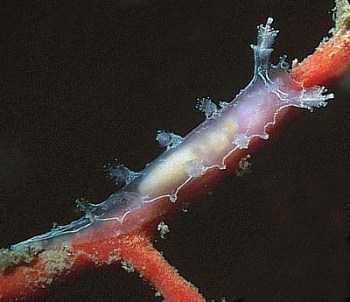
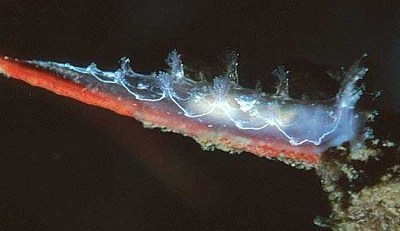
Hello Bill,
Diving at Roses, Costa Brava, Spain, we found this beautiful tritoniid nudibranch. Among its main characteristics we observed the two white stripes running along the translucent body. These pictures were taken in 10 metres of water over a rocky bottom and the animal was on an orange Lophogorgia gorgonian.
All our previous Tritonia findings on these gorgonians corresponded to Tritonia nilsodhneri, but this specimen doesn't match the characteristics for this species, so we suspect it could be a Tritonia lineata.
Any help on this identification is welcome.
The gorgonian prey has been identified as Leptogorgia sarmentosa (Esper, 1789). See message from Helmut Zibrowius: 23 Oct 2001.
Miquel
mpontes@marenostrum.org
Pontes, M., 2001 (Sep 29) Possible Tritonia lineata? from Spain. [Message in] Sea Slug Forum. Australian Museum, Sydney. Available from http://www.seaslugforum.net/find/5293Dear Miquel,
This is an interesting find. I can't see the oral veil very clearly but it doesn't seem to have the few long tapering oral tentacles that are found in most of the smaller European tritoniids, including T. lineata.
Hopefully someone in Europe will recognise it.
Best wishes,
Bill Rudman
